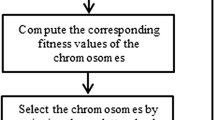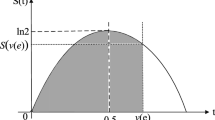Abstract
The traditional portfolio models assume securities’ returns are normally distributed and the future distribution of returns is the same as the historical distribution. For the two stringent assumptions, this paper develops two entropy-based portfolio optimization models which are flexible and effective in measuring risk. The second motivation of this paper is to combine the fuzzy time series technique to portfolio optimization. In fact, forecasting securities’ returns distribution is an important issue for portfolio. And among the many forecasting methods, the fuzzy time series technique is more suitable to deal with the fuzzy data in financial data. The empirical results on the historical data of the Stock Exchange in Chinese financial market show effectiveness of the proposed models. Both the entropy based models outperform the traditional ones and the fuzzy time series forecasting model also helps to further improve the actual performance.



Similar content being viewed by others
References
Artzner, P., Delbaen, F., Eber, J. M., & Heath, D. (1999). Coherent measures of risk. Mathematical Finance, 9(3), 203–228.
Cai, X. Q., Teo, K. L., Yang, X. Q., & Zhou, R. X. (2000). Portfolio optimization under a minimax rule. Management Science, 46(7), 957–972.
Cui, H. B., Zhao, X. N., & Zhang, L. B. (2004). On the application of a method of measuring security investment risks. Systems Engineering, 22(3), 123–129.
Freitas, F. D., De Souza, A. F., & de Almeida, A. R. (2009). Prediction-based portfolio optimization model using neural networks. Neurocomputing, 72(10), 2155–2170.
Gaivoronski, A. A., & Stella, F. (2003). Online portfolio selection using stochastic program. Journal of Economic Dynamics and Control, 27(6), 1013–1043.
Huang, X. X. (2008). Mean-entropy models for fuzzy portfolio selection. IEEE Transactions on Fuzzy Systems, 16(4), 1096–1101.
Huarng, K. (2001). Effective lengths of intervals to improve forecasting in fuzzy time series. Fuzzy Sets and Systems, 123(3), 387–394.
Konno, H., & Yamazaki, H. (1991). Mean-absolute deviation portfolio optimization model and its applications to tokyo stock market. Management Science, 37(5), 519–531.
Li, S. T., Cheng, Y. C., & Lin, S. Y. (2008). A fcm-based deterministic forecasting model for fuzzy time series. Computers & Mathematics with Applications, 56(12), 3052–3063.
Li, P. K., & Liu, B. D. (2008). Entropy of credibility distributions for fuzzy variables. IEEE Transactions on Fuzzy Systems, 16(1), 123–129.
Markowitz, H. (1952). Portfolio selection. The Journal of Finance, 7(1), 77–91.
Rockafellar, R. T., & Uryasev, S. (2000). Optimization of conditional value-at-risk. Journal of Risk, 2, 21–42.
Rodder, W., Gartner, I. R., & Rudolph, S. (2010). An entropy-driven expert system shell applied to portfolio selection. Expert Systems with Applications, 37(12), 7509–7520.
Singh, P., & Borah, B. (2013). High-order fuzzy-neuro expert system for time series forecasting. Knowledge-Based Systems, 46, 12–21.
Song, Q., & Chissom, B. S. (1993). Forecasting enrollments with fuzzy time series: part I. Fuzzy sets and Systems, 54(1), 1–9.
Usta, I., & Kantar, Y. M. (2011). Mean-variance-skewness-entropy measures: a multi-objective approach for portfolio selection. Entropy, 13(1), 117–133.
Wu, M., Kong, D. W., Xu, J. P., & Huang, N. J. (2013). On interval portfolio selection problem. Fuzzy Optimization and Decision Making, 12(3), 289–304.
Yu, M., Takahashi, S., Inoue, H., & Wang, S. Y. (2010). Dynamic portfolio optimization with risk control for absolute deviation model. European Journal of Operational Research, 201(2), 349–364.
Yu, M., Bian, Jz, Xie, H. b, Zhang, Q., & Ralescu, D. (2013). Study on the resampling technique for risk management in the international portfolio selection based on chinese investors. International Journal of Uncertainty, Fuzziness and Knowledge-Based Systems, 21(01), 35–49.
Zadeh, L. A. (1965). Fuzzy sets. Information and Control, 8(3), 338–353.
Zhou, R. X., Cai, R., & Tong, G. Q. (2013a). Applications of entropy in finance: A review. Entropy, 15(11), 4909–4931.
Acknowledgments
This work is supported by the National Natural Science Foundation of China Grant No. 71171012 and No. 70901019, the training plan of science research of undergraduate of Ministry of Education of the People’s Republic of China Grant No. 201310010049, Chinese Universities Scientific Fund of Beijing University of Chemical Technology (No. ZZ1319, ZY1321), the National Science and Technology Support Program (No. 2013BAK04B02) and Taft Travel Grants. This work is also supported by Humanity and Social Science Foundation of Ministry of Education of China (No.14YJA790075), Program for Excellent Talents, UIBE.
Author information
Authors and Affiliations
Corresponding author
Rights and permissions
About this article
Cite this article
Zhou, R., Yang, Z., Yu, M. et al. A portfolio optimization model based on information entropy and fuzzy time series. Fuzzy Optim Decis Making 14, 381–397 (2015). https://doi.org/10.1007/s10700-015-9206-8
Published:
Issue Date:
DOI: https://doi.org/10.1007/s10700-015-9206-8




